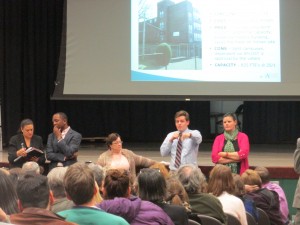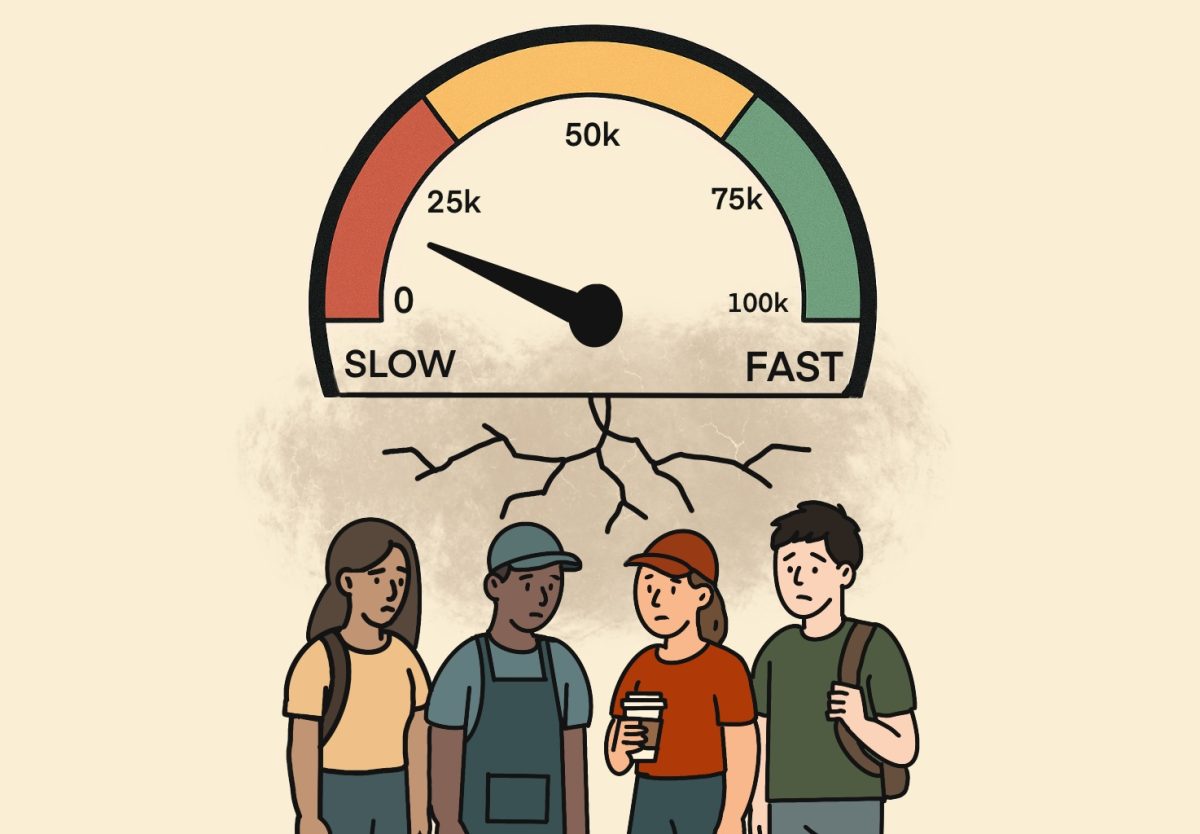
When school board member Matt Westmoreland addressed the Inman community at a Feb. 19 meeting to discuss overcrowding in the cluster, he reminded the audience of the pain the issue has caused in the recent past.
“Three years and three months ago, I was sitting on the second to last row in this room, where Erroll Davis sat on the stage, and that was the night that the maps came out,” Westmoreland said. “Over the next four or five months this cluster and this school system went through a very painful and divisive process that we call redistricting.”
Three years and three months later, parents, teachers and neighbors filled the auditorium at Inman Middle School once again to try to address the long-term overcrowding issues at Inman and in the entire Grady cluster. For years, the Inman attendance zone has been one of Atlanta Public Schools’ most populous. In July 2013, after extensive dialogue and community conversations, APS decided to move forward with adding eight new classrooms to the existing Inman site. In January, however, APS Superintendent Meria Carstarphen sent a letter to Inman parents informing them that the plans for expanding the school were on hold. She decided to delay the project because of two new major factors—increased enrollment projections and the possible annexation of the Druid Hills community into the City of Atlanta.
“I know that three years and three months is a long time to not have a solution yet, and I know that we haven’t offered a final solution tonight,” Westmoreland said at the meeting. “But we sincerely want to hear what you think so that we can factor that into the long-term decision that is made.”
In July 2012, Interim Superintendent Erroll Davis convened a task force to study the Inman overcrowding situation and to make recommendations. The task force considered three suggestions to relieve Inman overcrowding. All three involved splitting the district so that instead of all five elementary schools feeding into one middle school—Inman—they would add a second middle school in the Grady cluster. Because of parents’ extreme opposition to that proposal, however, Davis decided to keep the district together and expand Inman instead.
With any option of splitting the district off the table, the district then developed a plan that would add 20,000 square feet to Inman to accommodate the overcrowding. With this new plan, Westmoreland promised neighbors the expansion would be sufficient to accommodate all new students and also allow for the removal of all the trailers currently on the Inman campus. The expansion was to begin in January 2015 and last for 18 months.
Over the recent winter break, 22 trees throughout the Inman campus were marked for removal with large orange X’s. This action took the neighborhood completely by surprise and many were outraged, as several of the trees were not near the planned construction site. Tree appeals were filed with the City of Atlanta, meetings were held with Westmoreland and he met with Carstarphen to express the neighbors’ concerns. Several neighbors, including Bonny Valente and Lee Wilson, who live on Clemont Drive, and have been associated with Inman their entire lives, also began around this time to push back against the expansion itself not just the destruction of the trees.

“I was pretty ignorant about the whole thing until the X’s came on the trees,” Valente said. “And we didn’t know in the immediate neighborhood what that meant. The neighborhood had already been through a couple of expansions, and every time, we were promised it would be the last time. The last expansions were in ’81, ’93 and ’04, and we’ve lived through all three of these. The capacity at Inman is 875 students, and now they’re at 1,001, projected to be at 1,100 by 2016. This site simply cannot handle that kind of capacity.”
Then on Jan. 29, Carstarphen sent a letter to the Inman community saying she was delaying construction and that a community meeting was scheduled for Feb. 19. Carstarphen said APS is not canceling construction, but rather altering the current plan because it will not solve the problem.
“What became crystal clear to us is that the enrollment projections, and parents have been saying this for some time, were pretty significant,” Carstarphen said. “So, if we were to build out what we have, it would not fix the problem at all.”
She said the expanded school would immediately need portable classrooms, and that the district will seek input from parents on a new design. But, she’s quick to add, this is a nice problem for a community to have.
“There are other schools across the district that are grossly under-enrolled,” she said. “This is one where, yes, it’s a challenge, but it’s a wonderful opportunity for us to get really creative and do something that would make that community proud.”
After the community meeting, the district is now considering three new possibilities to address capacity concerns for the Inman community. The first is the addition of 14 classrooms to the existing Inman building. This addition is expected to cost $15 million and would accommodate 1,250 students at the school, an expanded capacity that did not seem to sit well with the community members present at the meeting.
“Having been in this neighborhood for a number of years, we were told twice that the two previous expansions would be the last expansions, that the school footprint was too large of a site,” said Andrew Paul, an Inman parent and member of the Virginia Highland Neighborhood Association. “We were told there would be no further expansions, not only because of the green space, but because of the traffic. We’ve been great neighbors. Our children have gone through the school, they continue to go through the school, and we want to continue to be great neighbors. And that means respect for the school, but also respect for the neighborhood and the environment.”
The second and third scenarios involve utilizing the former David T. Howard High School building to relieve the overcrowding. These scenarios could involve either a sixth grade campus at the Howard school site or an eighth- and ninth-grade Junior High School option that would relieve overcrowding at Grady as well.

The former Howard High School building, located in the Old Fourth Ward, has been considered for many potential uses, both educational and community-based. The community has asked the district to identify a restoration plan for this historic building for years, and these two scenarios under consideration would allow the district to address this concern as well.
The two potential projects at the former Howard site are estimated to cost the same amount – $33 million. When these two proposals were mentioned at the meeting, the packed auditorium erupted into cheers.
“I think the community definitely wants to get behind Dr. Carstarphen and her ideas,” said Dr. Betsy Bockman, Inman principal. “They seemed to be very happy about the Howard possibility, so that makes everybody feel better …. I think Inman is in a great part of the city. I want us to come up with a plan that can make most people happy because I want people to continue to choose Inman and Grady.”
One other option, mentioned by Inman parent Jennifer Errion at the meeting, involves moving Inman into Grady, building a new high school, and making Inman an elementary school. This would alleviate overcrowding in the cluster but is cost prohibitive according to Carstarphen because building a new high school today would be a $120 million proposition.
“It’s going to be very important that we figure out how we want to use the investment that we have available of $13 million,” Carstarphen said, “… and if we really can find a solution that addresses all these things and can be done in a reasonable time frame with a reasonable amount of money, then we should do it.”
All of these possible scenarios on the table for the future of Inman could be reconsidered if Atlanta annexes Druid Hills. APS has not been directly engaged in the Druid Hills annexation discussions, but they believe that the annexation would provide APS three additional buildings in an area adjacent to the Grady-Inman cluster. Those additions to the district could also alleviate overcrowding in existing schools. There are many factors involved in the annexation, ranging from transportation issues to county services, but the state legislature is expected to make a decision on what will happen by the close of this session, in April. If the legislature decides that the annexation could go on a local referendum, that vote will be decided by Druid Hills residents in November.
“It’s not our decision,” Carstarphen said. “There is a lot going on in this, and it is going to in part drive us when we consider triggering the next decision. The most important thing for us is that there would be actual facilities, a high school and two middle schools, that might be part of Atlanta, which would mean that around 1,600 students would be coming into APS. How that gets shuffled out, we have to cross that bridge when we get to it.”
The decision-making timeline for Inman will run parallel with the decision about the Druid Hills annexation, at which point APS will be prepared to move forward with one of the proposed scenarios.
With Carstarphen’s letter and this pause in immediate expansion to Inman, APS has had an opportunity to reexamine the needs of the entire cluster in light of booming population growth. The community, along with faculty and parents of Inman, are hopeful and optimistic for what the future holds.
“This is such a wonderful opportunity for Atlanta to kind of create a visionary Midtown,” Errion said. “[Carstarphen] impressed me as a superintendent with vision because we really need a visionary right now, someone who will really take all of our concerns to heart and do what’s best for all of our children.”







